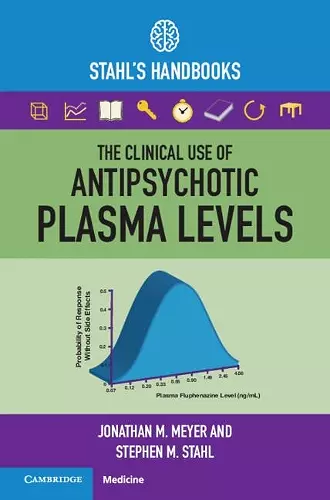The Clinical Use of Antipsychotic Plasma Levels
Stahl's Handbooks
Stephen M Stahl author Jonathan M Meyer author
Format:Paperback
Publisher:Cambridge University Press
Published:2nd Sep '21
Should be back in stock very soon

A comprehensive and accessible guide to using antipsychotic levels for optimizing effectiveness and monitoring oral antipsychotic adherence.
The first clinically oriented handbook on using antipsychotic levels for managing adherence and optimizing treatment effectiveness. Covers concepts of response threshold, the point of futility and correlations between antipsychotic dosages and trough levels. For all clinicians working with psychiatric patients receiving antipsychotic therapy.Clinicians recognize that monitoring psychotropic levels provides invaluable information to optimize therapy and track treatment adherence, but they lack formal training specifically focused on the use of plasma antipsychotic levels for these purposes. As new technologies emerge to rapidly provide these results, the opportunity to integrate this information into clinical care will grow. This practical handbook clarifies confusing concepts in the literature on use of antipsychotic levels, providing clear explanations for the logic underlying clinically relevant concepts such as the therapeutic threshold and the point of futility, and how these apply to individual antipsychotics. It offers accessible information on the expected correlation between dosages and trough levels, and also provides a clear explanation of how to use antipsychotic levels for monitoring oral antipsychotic adherence, and methods to help clinicians differentiate between poor adherence and variations in drug metabolism. An essential resource for psychiatrists, psychiatric nurse practitioners, and mental health professionals worldwide.
'As we redouble our efforts to achieve the goals of personalized medicine, therapeutic drug monitoring (TDM) can play a critical role. Individuals vary enormously in how they absorb and metabolize different medications and which impactful environment factors or co-occurring conditions they might encounter. In my view, the potential value of the knowledge that can be provided by TDM has been given less attention than it deserves. Meyer and Stahl have done an excellent job of reviewing this topic. They address all necessary perspectives, from optimizing response and tolerability to better monitoring of adherence and help to explain idiosyncratic or unexpected medication effects, as well as the timing and interpretation of plasma levels. This is an extremely useful text for anyone involved in the use of antipsychotic drugs.' John M. Kane, Professor and Chairman, Department of Psychiatry, Donald and Barbara Zucker School of Medicine at Hofstra/Northwell
'Dr Meyer and Stahl have succeeded again in providing a well-written and evidence-based handbook with a focus on the use of antipsychotic plasma levels. This book offers so much more than a comprehensive review on the topic, and provides us with important clinical pearls and helpful summarized recommendations. Most importantly, we walk away with having a good understanding and solid rationale for when and why plasma levels are important, but also a having a reference we can revisit time and time again.' Deanna L. Kelly, Professor of Psychiatry, Director, Treatment Research Program (TRP), Maryland Psychiatric Research Center (MPRC), University of Maryland School of Medicine
'As personalized medicine in the field of psychopharmacology is turning from hope to hype, the need for precision tools in clinical practice is constantly growing. Measuring antipsychotic plasma levels in patients prescribed antipsychotic medications, known as therapeutic drug monitoring (TDM), is a well-established method to account for the unique characteristics of each patient to aid in appropriate dose selection. Dr Meyer provides a comprehensive and readily comprehensible overview of the theoretical and practical framework for the effective use of TDM in clinical routine to improve the efficacy and safety of antipsychotic medications. Integrating TDM evidence for use in common clinical challenges in the practice of psychopharmacology, this book comprises an essential practical guide for routine TDM practice, a must-read work for all mental health professionals prescribing antipsychotic medications.' Georgios Schoretsanitis, The Zucker Hillside Hospital, Northwell Health, Glen Oaks, New York, USA; University Hospital of Psychiatry Zurich, Zurich, Switzerland
'The use of antipsychotic plasma levels - or therapeutic drug monitoring - is a valuable tool but underutilized by practicing clinicians due to the difficulties in interpretation. The strength of this volume lies in its thoughtful framework for interpreting plasma level information for different antipsychotics for individual patients treated under different circumstances. The book addresses how plasma concentrations can be helpful during long-term maintenance treatment when patients are being treated with oral or long-acting injectable medications. Readers also learn how to differentiate non-adherence from kinetic effects that lower drug levels. For all of these and other clinical circumstances, Meyer and Stahl provide both a scholarly and very accessible approach that can improve the practice of any clinician who prescribes an antipsychotic.' Stephen R. Marder, Daniel X. Freedman Professor of Psychiatry, Vice Chair for Education, Semel Institute for Neuroscience at UCLA; Director, VA VISN 22 Mental Illness Research, Education, and Clinical Center
'Drs. Jonathan Meyer and Stephen M. Stahl provide a comprehensive review of the state of the knowledge on the use of antipsychotic plasma levels for the management of patients with schizophrenia, as well as useful practical information for practicing clinicians. The handbook is written and organized in a manner that facilitates the learning of new concepts and its use as a reference tool. It should be an invaluable resource for clinicians facing the frequent scenario of patients exhibiting poor response or poor tolerance to the prescribed antipsychotic drug. It is to be hoped that this handbook and other dissemination efforts expand the use of therapeutic drug monitoring of antipsychotic treatment.' Marcela Horvitz-Lennon, Senior Physician Scientist, RAND Corporation; Associate Professor, Cambridge Health Alliance and Harvard Medical School
ISBN: 9781009009898
Dimensions: 186mm x 125mm x 20mm
Weight: 440g
400 pages